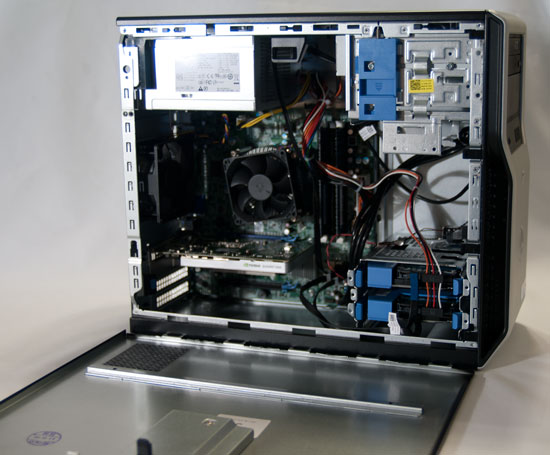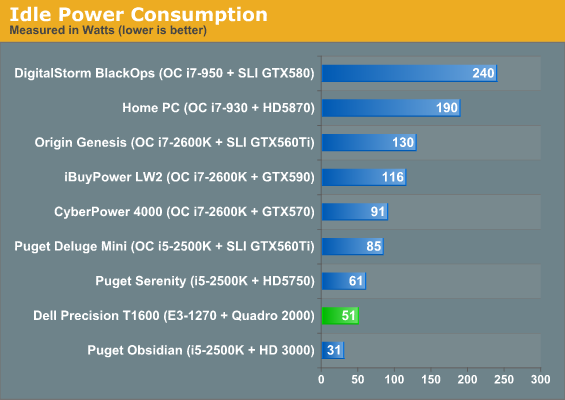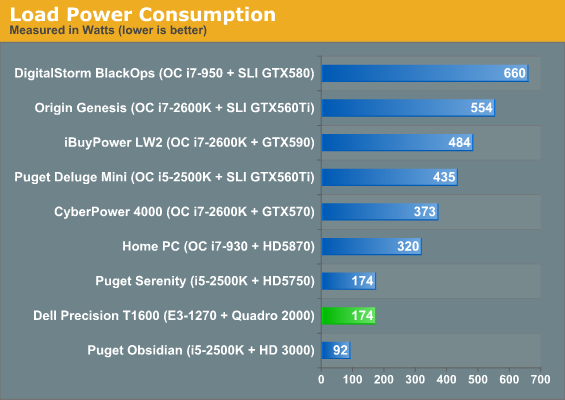Dell Precision T1600: Workstation Class
by Dustin Sklavos on May 2, 2011 4:55 PM EST- Posted in
- Systems
- IT Computing
- Dell
- Intel
- Xeon
- Precision
- Workstation
- Enterprise
- NVIDIA
Build, Noise, Heat, and Power Consumption
Happily, we're now in the disciplines where a machine like the Dell Precision T1600 is designed to excel. One of the nicer things I've found in working with a lot of Dell desktops, and it's something I'm pleased to see has very much carried over to the T1600, is how easy they are to service. The T1600's chassis is extremely easy to open and work inside, and for a small tower it's remarkably spacious and well-organized.

The side panel is held on with a latch that's both secure and simple to use. Once you're inside, you're met with a very basic assembly and a traditional ATX enclosure style. Cabling could be neater but generally speaking I found the Precision T1600 easy enough to get into and work with.
Given the combined power of the processor and graphics card at just 142 watts, Dell doesn't have to do much work to keep the chassis cool. As a result, even under heavy load the T1600 was whisper quiet and inaudible under ambient noise. The stock cooler on the Xeon E3-1270 doesn't have to work very hard, and as you'll see the heatsink/fan unit on the Quadro 2000 is more than adequate for keeping it cool.

Idle and load temperatures are relatively frosty. The peak temperature of the Quadro 2000 is reasonable and even somewhat low, while the E3-1270 (read in HWMonitor as an i7-2600K) stays very cool even under the stock fan. The readings on the ECC memory are also telling: idle and load temps are quite low, and the DIMMs have no trouble cooling off once the system idles.
UPDATE: Power consumption listed below.


















29 Comments
View All Comments
TrackSmart - Monday, May 2, 2011 - link
I appreciate you calling Dell out on the insane pricing structure, but I think even greater outrage was warranted. If Dell wants to add $200/machine to cover the cost of software certifications and support, I'm fine with that. That would be honest pricing. HOWEVER, that's not what they do. Instead they charge $345 to upgrade to a 1GB hard disk, which costs $70 at retail. That's just plain outrageous and *deserves* outrage. Don't be afraid to call it as you clearly see it!Exelius - Tuesday, May 3, 2011 - link
Forgive me; I just took a pricing class where the mantra was "your customer is your enemy and your competitors are your friends who you cannot legally talk to." But the reason they do this is because the people who purchase this type of machine are often engineering firms. Revvit files are MASSIVE, so disk space is definitely a priority. But you have 2 types of engineering firms who buy these; large ones who order 25-50 at a time and who will likely be installing a pre-built image anyway, or small firms who are ordering less than 5 machines. The labor to build an image for 5 machines isn't worth the $1500 you'd spend upgrading the disk on those machines directly.Customers who aren't willing to pay a high price for more disk space likely aren't willing to pay much of anything for more disk space, as they're just going to install their own disks anyway. So gouge the shit out of the customers who are. The biggest lesson I learned from that class is that these feature prices are very carefully calculated, and cost is only a consideration when the optimal price you can charge is less than the cost of the feature.
mariush - Monday, May 2, 2011 - link
The page titled "Build, Noise, Heat, and Power Consumption" has almost no mention of actual power consumption.Just a fleeting mention of 142 watts but it's not clear if you just added up the 80w tdp of the cpu and the watts for the video card to get this value.
Please get a Kill-a-watt type of device and measure power in idle and when doing something cpu intensive, at least.
It would also be nice to get the idle power usage and then replace the power supply with another power supply that you know how efficient it is, to actually determine the actual power efficiency of this 260 something power supply Dell provides.
I have a suspicion that 65% is for maybe 20% load but if the system uses 140 watts when in use, the efficiency should be a bit higher.
Dustin Sklavos - Tuesday, May 3, 2011 - link
Actually, I did use a Kill-a-watt power meter. Those idle and load numbers are exactly how things worked out.7Enigma - Tuesday, May 3, 2011 - link
I'm sorry Dustin, what idle power numbers? I can only see the 142w which I'm assuming is load you measured but don't see any idle numbers. I would also second the request for a quick replacement using an 80+ efficiency PSU and retesting idle/load values.Honestly the combination of POS PSU and RAID 0 with no backup for a workstation is downright laughable IMO.
Dustin Sklavos - Tuesday, May 3, 2011 - link
You're absolutely right. The graphs were in the system, just didn't get posted. I've added them.7Enigma - Tuesday, May 3, 2011 - link
Dell are you kidding me? Of all the places where RAID 0 has it's place a workstation is about the worst place I could possibly think of.meorah - Tuesday, May 3, 2011 - link
I appreciate the effort that this site is taking to broaden its horizons beyond just gaming/enthusiast systems and appealing more to the IT side of computing.That being said, this review contains many pointless graphs that should have been edited out, and just because Dustin was curious about how well this workstation runs CoD and SC doesn't mean you should let him run useless tests. It would have been much more beneficial to have him run the workstation benchmarks on all the boutique builds so he would have a reasonable baseline chart to compare how much better the nvidia 2000 can handle its intended applications than a high-end gaming system.
And yes Dell charges too much for memory and drives... I don't believe I've ever built a single virtual server host with factory upgraded RAM/HDD. Just base config them and save about $2k per host by buying your own memory and drives.
ochentay4 - Tuesday, May 3, 2011 - link
im my opinion, the only important benchmarks when testing a workstation are cinebench 11.5 and specviewperf. maybe use pcmark and 3dmark and cinebench 10. why test games?the most important thing is to see is how a gaming machine with similar specs compares to this workstation, and this article fails at that.
rangerdavid - Tuesday, May 3, 2011 - link
I realize prices change on a daily basis, but maybe you could take a date-stamped snapshot of prices, and then normalize the scores of some of these test by system price. I think that would be really fascinating, especially for someone like me that edits a lot of video on a budget (as much as one can, dealing with video) - instead of raw x264 encoding speeds, give me [(raw x264 speed) / price].At least, maybe provide this kind of graph once in a review, using whatever metric you think works best divided by price.